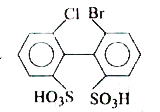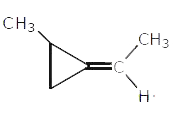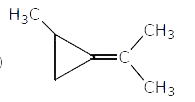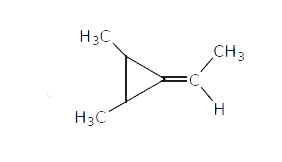Which will show optical isomerism
3, 3-dichloropentane
2-chloro-2-butanol
2-chloro-2-propanol
All of these
The correct Answer is:B
To determine which compound shows optical isomerism, we need to identify if there is a chiral center present in the molecules. A chiral center is typically a carbon atom that is bonded to four different groups. Here's a step-by-step solution:
Step 1: Identify the Compounds
We need to analyze the given compounds. The question mentions "three dichloropentane" and "2-propanol."
Step 2: Analyze 3-Dichloropentane
1. Structure: The structure of 3-dichloropentane can be represented as:
- CH3-CHCl-CHCl-CH2-CH3
2. Chiral Center: The carbon at position 3 (the one bonded to two chlorine atoms and two different alkyl groups) is a chiral center because it is attached to four different groups:
- Methyl group (CH3)
- Ethyl group (CH2-CH3)
- Chlorine (Cl)
- Hydrogen (H)
3. Conclusion: Since it has a chiral center, 3-dichloropentane can show optical isomerism.
Step 3: Analyze 2-Propanol
1. Structure: The structure of 2-propanol can be represented as:
- CH3-CHOH-CH3
2. Chiral Center: The carbon atom bonded to the hydroxyl group (OH) is not a chiral center because it is attached to two identical methyl groups (CH3).
3. Conclusion: Since there is no chiral center, 2-propanol does not show optical isomerism.
Final Conclusion
Among the compounds analyzed, 3-dichloropentane shows optical isomerism because it has a chiral center, while 2-propanol does not show optical isomerism due to the presence of two identical groups.
We need to analyze the given compounds. The question mentions "three dichloropentane" and "2-propanol."
1. Structure: The structure of 3-dichloropentane can be represented as:
- CH3-CHCl-CHCl-CH2-CH3
2. Chiral Center: The carbon at position 3 (the one bonded to two chlorine atoms and two different alkyl groups) is a chiral center because it is attached to four different groups:
- Methyl group (CH3)
- Ethyl group (CH2-CH3)
- Chlorine (Cl)
- Hydrogen (H)
3. Conclusion: Since it has a chiral center, 3-dichloropentane can show optical isomerism.
1. Structure: The structure of 2-propanol can be represented as:
- CH3-CHOH-CH3
2. Chiral Center: The carbon atom bonded to the hydroxyl group (OH) is not a chiral center because it is attached to two identical methyl groups (CH3).
3. Conclusion: Since there is no chiral center, 2-propanol does not show optical isomerism.
Among the compounds analyzed, 3-dichloropentane shows optical isomerism because it has a chiral center, while 2-propanol does not show optical isomerism due to the presence of two identical groups.
Topper's Solved these Questions
- GENERAL ORGANIC CHEMISTRY BOOK - ERRORLESSCHAPTER - GENERAL ORGANIC CHEMISTRY EXERCISE - PAST YEARS QUESTIONS
85 Videos
- GENERAL ORGANIC CHEMISTRY BOOK - ERRORLESSCHAPTER - GENERAL ORGANIC CHEMISTRY EXERCISE - ASSERTION AND REASON
14 Videos
- GENERAL ORGANIC CHEMISTRY BOOK - ERRORLESSCHAPTER - GENERAL ORGANIC CHEMISTRY EXERCISE - NCERT BASED QUESTIONS (Organic Reactions and their Mechanism )
46 Videos
- ENVIRONMENTAL CHEMISTRYBOOK - ERRORLESSCHAPTER - ENVIRONMENTAL CHEMISTRYEXERCISE - ASSERTION & REASON
7 Videos
- HYDROCARBONSBOOK - ERRORLESSCHAPTER - HYDROCARBONSEXERCISE - ASSERTION & REASON
18 Videos
Similar Questions
Knowledge Check
Which of the following will show optical isomerism? .
A B
B C
C D
D
Which of the following will show optical isomerism as well as geometrical isomerism.
A B
B C
C D
D
Which of the following will show optical isomerism?
A B
B C
C D
D
Which of the following will not show optical isomerism ?
View SolutionWhich one of the following compound will show optical isomerism ?
View SolutionWhich one of the following will show optical isomerism?
View SolutionAn organic compound will show optical isomerism if ________.
View SolutionAn oranic compound will show optical isomerism if in its molecule
View Solution
